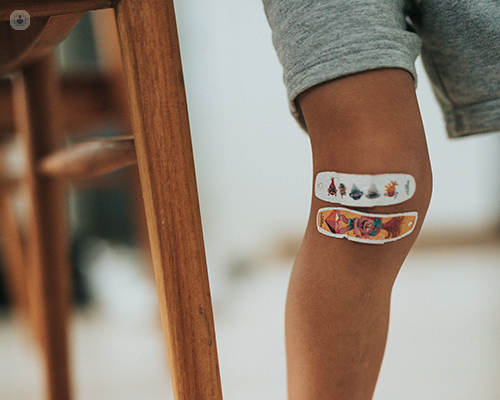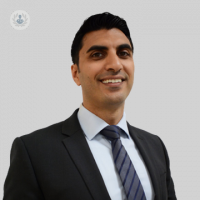Knee injuries in children and young adults
Written by:How common are knee injuries in children?
Unfortunately over the last few years, doctors have seen a rise in knee injuries in children. This is due to a variety of factors.
They have seen a greater uptake in structured sport at a young age. With a higher uptake in sport, there is a exposure to higher energy contact and non-contact injuries which can lead to significant knee injuries.

One of the unique challenges often seen by surgeons in children and young adults is the presence of growth plates in the bone, which can significantly complicate some treatment strategies
The fact that the bone is still growing can significantly affect some of the surgical options that may be suggested or how surgery is approached.
When treating injuries in younger individuals, all decision making, whether down an operative or non-operative route, must balance out some of the risks and complications from the injury itself. It must balance out some of the potential effects that surgery may have on the individual with respect to their growth.
What are the signs and symptoms of a significant knee injury?
Significant knee injuries can occur in all types of sports. However, significant knee injuries can commonly be seen in pivoting sports such as football, rugby or sports with cutting maneuvers.
It isn’t correct to think that significant injuries only come from injuries which occur with significant contact.
The mainstay of pediatric knee injuries is the injury to the ACL ligament, which is often sustained through a non-contact twisting mechanism. For example, somebody may be taking averting action from an oncoming player and the knee will pivot and be significantly injured.
The main sign of this injury is significant pain, pain that makes you unable to finish the match and significant swellling which occurs either immediately or in the early acute phase.
A significant knee injury is one which causes subsequent immediate pain, that limits your ability to continue, or to weight bear and is associated with significant swelling. It can be either contact or non-contact.
In a more chronic setting, doctors find that the knee often settles down and then patients find a lack of confidence in their knee or a frank instability. They get a feeling that the knee is moving in an abnormal manner.
What is the best way to get a diagnosis?
A very common situation would be that the individual will recognise themselves as having a big injury and will attend emergency services. They may spend time in the emergency department and have a basic x-ray and a basic assessment. When the x-ray is reported as normal, it will be then sent away as a soft tissue injury with no further imput or management.
However, these individuals do need further imput and management. If you’re worried that you’ve had a significant injury, it is imperative that you’re reviewed by the appropriate specialist.
It is imperative that these injuries are not put to one side because not only can doctors miss a significant amount of these injuries by not following through with them but some of the treatment strategies either with early brace therapy or some of the surgical strategies may be time ctitical.
Sometimes as little as two to three weeks of delay can affect some of the surgical solutions available.
What does the anterior cruciate ligament (ACL) do?
The Anterior cruciate ligament (ACL) is one of the four major ligament complexes within the knee. It is often thought of as the ‘footballer’s ligament’, the ligament that many footballers rupture..
It has two important functions. One function is that it stops the front to back movement of the thigh bone against the shin bone.
The secondary function is that it helps with rotational stability.
With an ACL injury, the sensation from the individual in the early phase is pain and swelling and the later phase is lack of trust in the knee.
Many patients with ACL injury say they don’t trust their knee in any change of direction. Running in a straight line without the ACL may be fine but once they try to twist or turn or change direction, the knee will want to give out.
Without the ACL, pivoting sports such as football, side stepping maneuvers and racket sports can become very challenging.
What are the options for treating the ACL?
ACL treatment options for children and young adults are not necessarily the same as the treatment options for adults.
Doctors have consideration for non-operative managment, which is activity modification- brace therapy and physiotherapy.
As a general rule, in older adults, ACL reconstruction is typically considered, to get the individual back to proper sporting activity.
A reconstruction essentially involves removing the torn part of the ACL or removing part of it and recreating a new ACL with donated tissue.
The most common practice in the UK is to take hamstring tendons from behind the knee and place them into the knee as a new ACL. That may also be an option in the younger adult population and the pediatric population.
When taking about reconstruction, doctors mean recreating an ACL. ACL repair is a very niche area, which is often aplicable to young individuals and is often a time critical procedure (the surgery needs to be conducted in the first few weeks). It involves reattaching the torn ACL back to its origin.
This works very well in the correct tear pattern and in pediatric populations where the ACL still has a high healing potential. It has not been proven to work well in adults. There is only a small number of potential scenarios when it would be appropriate for adults.
As a child or young adult you should consider early surgical consultation because the options may change.
In addition to these two major options of reconstruction and repair, there are a number of hybrid techniques and a number of very small print techniques, which is when a tendon can be taken from an adult and transplanted into a child.


